NETHERLANDS
Eindhoven

Eindhoven
Eindhoven
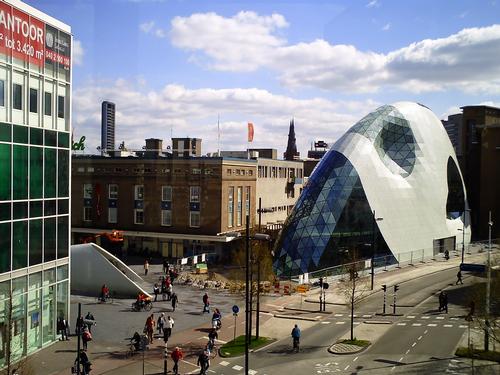 EindhovenPhoto: Curt Woyte CC 3.0 Unported no changes made
EindhovenPhoto: Curt Woyte CC 3.0 Unported no changes made
Eindhoven is the largest city in the south of the Netherlands and the 5th city in the Netherlands and is located in the province of North Brabant. Eindhoven is known for the technological innovation power of both the city and the surrounding region. This certainly has to do with the fact that the current electronics giant Philips was founded here in 1890. Eindhoven is a sprawling city with an area of 88.84 km². The city is perhaps best known outside the Netherlands for the football club PSV, which plays its matches in Eindhoven in front of an often sold out stadium.
Eindhoven is a real student city and has an exuberant nightlife. You can go out in many places, from cafes, grand cafés and discotheques to pubs. On the south side of the center is Stratumseind, the longest café street in the Netherlands. In the Bergen area, west of the center, there are mainly brown bars, often with live performances and terraces.
| advertisement |
| Hotels Eindhoven |
Location
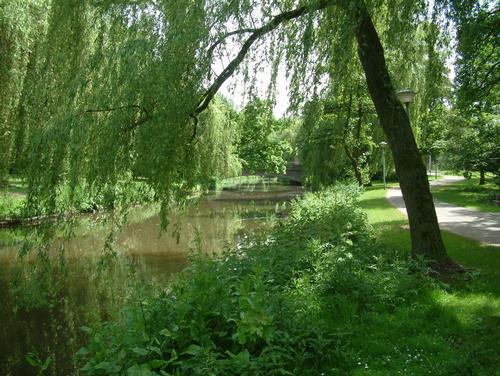 Dommel in EindhovenPhoto: Lempkesfabriek in the public domain
Dommel in EindhovenPhoto: Lempkesfabriek in the public domain
Eindhoven is located in the south of the Netherlands, not too far from the Belgian border, where the rivers Dommel and Gender intersect. Via the A2, Eindhoven is connected to the north with Den Bosch, Utrecht and Amsterdam and to the south with Maastricht. Eindhoven is connected to various European cities via Eindhoven Airport.
Weather
Like in the rest of the Netherlands, the climate in Eindhoven is rarely extreme. In summer, the weather in Eindhoven can be sunny and sometimes even a bit warm, but there are often a few wet days in between, so wearing a waterproof jacket is a necessity and not a luxury. In July and August, average daytime temperatures are around 23 °C.
The winter months can be slightly colder in Eindhoven than in many other parts of the Netherlands, because Eindhoven is not close to the sea. It regularly freezes at night in January and February. In April, temperatures in Eindhoven quickly rise again and regularly reach 15 °C.
History
Eindhoven started as a small village, which was probably called Endehoven. Hendrik I, the Duke of Brabant, granted Eindhoven city rights in 1232. He had plans to turn this modest village into a city of stature.
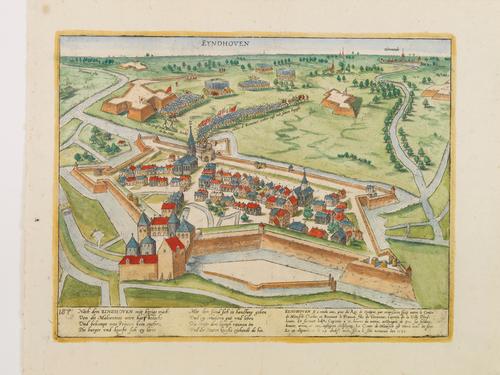 Siege of Eindhoven, mapPhoto:Public Domain
Siege of Eindhoven, mapPhoto:Public Domain
In the Middle Ages, control of the city was alternately in Dutch and Spanish hands. In 1486, Eindhoven was almost completely destroyed during a raid by the Duke of Gelre. Political instability made it necessary to strengthen Eindhoven. A castle is said to have been built here in the 15th century and the city walls were improved on several occasions. During a final siege of the city, which led to the capture by the Spanish troops, the walls were completely destroyed. From 1629 Eindhoven was part of the Republic of the Netherlands.
Eindhoven changed radically in the 19th century with the advent of the Industrial Revolution, a particularly important period in local history. In 1820 the road between Eindhoven and Liège was paved, making the movement of people and goods much easier between the two cities. Philips opened a factory to manufacture incandescent lamps in 1891. As more and more people and municipalities embraced modern electric lighting, the factory expanded to keep up with demand.
In the late 19th and early 20th century, other industries settled here, including the textile industry and the tobacco industry. The car industry later came to Eindhoven. The DAF factory was particularly important. By 1920 the population had grown to about 45,000 people. Many of them worked at Philips and lived in special residential areas built for employees of the company.
In the Second World War, Eindhoven did not escape damage caused by bombing. After the war, it was often decided to replace damaged historic buildings with modern counterparts, rather than restoring them. The conscious choice for contemporary architecture gives the city a very modern look.
The city has become a top technology and design center in Europe. Today Eindhoven is known as the “City of Light” and remains the home of Philips. The company plays a great role in the research and development of the technology.
Sights
Although perhaps not the most obvious city to visit in the Netherlands, Eindhoven has a lot to offer for tourists. Below are some of the most famous sights.
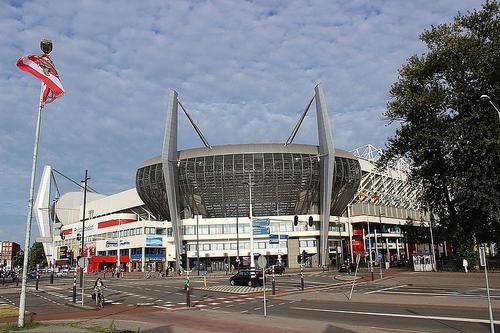 PSV Stadium EindhovenPhoto: Metro Centric CC 2.0 Unported no changes made
PSV Stadium EindhovenPhoto: Metro Centric CC 2.0 Unported no changes made
The Philips Stadium is one of the main attractions in Eindhoven and this stadium is the home of the successful PSV. The stadium's origins date back around 100 years, the capacity is now about 35,000 spectators and tickets can be scarce at important matches. Guided tours of the stadium and museum are worthwhile.
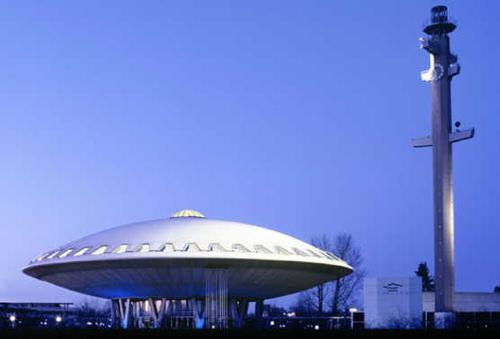 Evoluon EindhovenPhoto: Public Domain
Evoluon EindhovenPhoto: Public Domain
Originally built in 1966 as a Museum of Science and Technology, the Evoluon remains an iconic landmark and is currently used as a conference and meeting center. The building was designed by Louis Kalff and Leo de Bever. Even though the Evoluon is more than half a century old, the building still has a futuristic impression, with its shape of a flying saucer. The Evoluon is constructed from concrete and measures almost 80 meters in diameter.
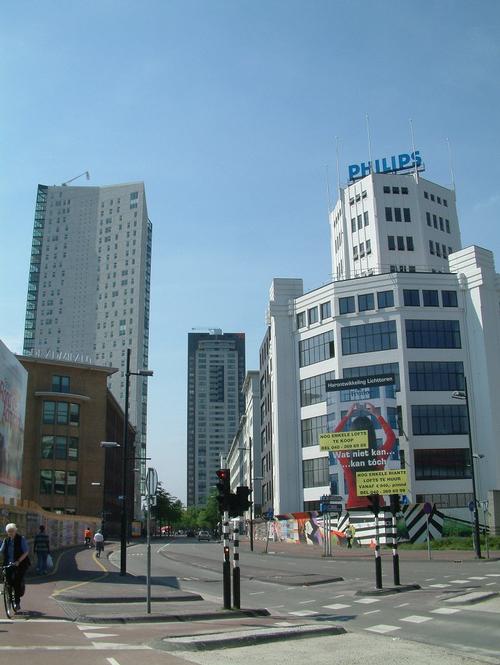 Eindhoven Witte DamePhoto: Lempkesfabriek CC 3.0 Unported no changes made
Eindhoven Witte DamePhoto: Lempkesfabriek CC 3.0 Unported no changes made
De Witte Dame was designed by Dirk Rossenburg as a sober, completely concrete factory building, according to the rules of the new professionalism. Philips used the building for the production of incandescent lamps. After the renovation in the 1990s, the public library, the Design Academy and Philips Design have been housed here.
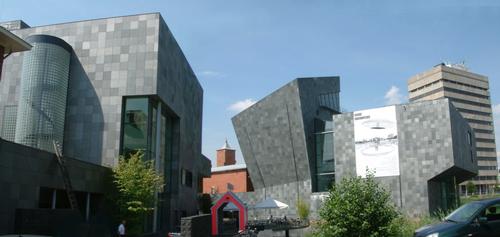 Van Abbemuseum EindhovenPhoto: Lempkesfabriek in the public domain
Van Abbemuseum EindhovenPhoto: Lempkesfabriek in the public domain
The Van Abbemuseum is a leading museum for modern and contemporary art. It is also interesting as a building with, in addition to the beautiful original 1930s design, a spectacular new section, designed by the Dutch architect Abel Cahen. The museum is known for being self-aware and has a nice collection of works by Chagall and Picasso, among others. In addition to these well-known artists, the museum provides space for innovative contemporary art and there is a great deal of attention for installations and moving images.
The Philips Museum opened its doors to the public after the official opening by Queen Beatrix in 2013. Here you will get a good idea of how the company has developed from a small light bulb factory into a large and leading global concern. You see the history of the company, but room has also been made for innovations.
Tips
Genneper Parken is fun for families and tourists. It is near the city center and offers a series of hiking trails and bicycle routes.
The Tongelreep swimming paradise is close to the center of Eindhoven and is one of the largest and best swimming pool complexes in the Netherlands.
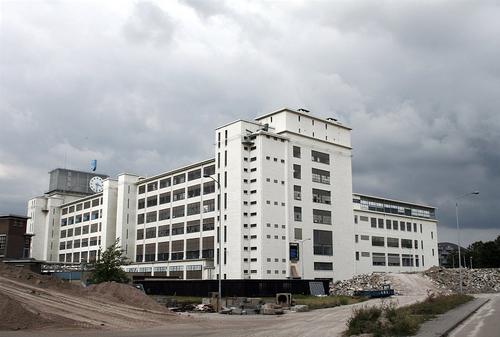 Eindhoven Strijp-SPhoto: Robert de Greef CC 3.0 no changes made
Eindhoven Strijp-SPhoto: Robert de Greef CC 3.0 no changes made
Pay a visit to Strijp-S, the former Philips factory site. In 2004 Philips sold this site to Park Strijp Beheer. It is now being developed as a breeding ground for the creative sector and the Dutch Design Week is also organized here. You can book a tour of the site at the tourist office.
Eindhoven Museum consists of a heritage park and a museum collection. In the Genneper Parken area, the heritage park portrays the life of ordinary people from Eindhoven in prehistoric times and the Middle Ages. Houses and farms have been reconstructed following archaeological excavations.
The museum collection includes a variety of works and objects that give a good picture of the past of Brabant and Eindhoven. These objects are also exhibited in other museums and at special locations in and around Eindhoven.
Useful links Eindhoven
BBC Country ProfilesWorld Fact Book Explore all Countries
How to call
Last updated June 2025
Copyright: Team - The World of Info